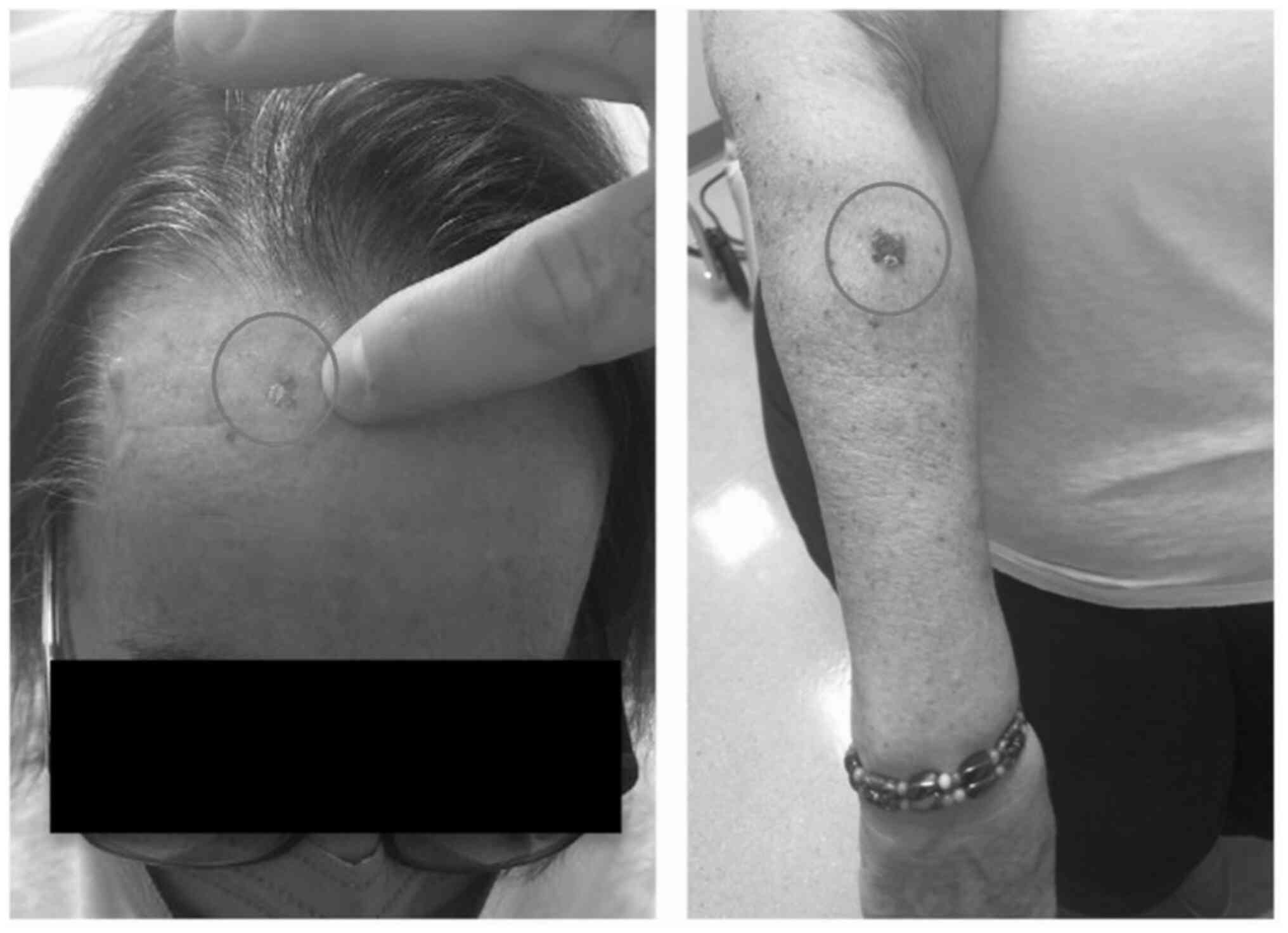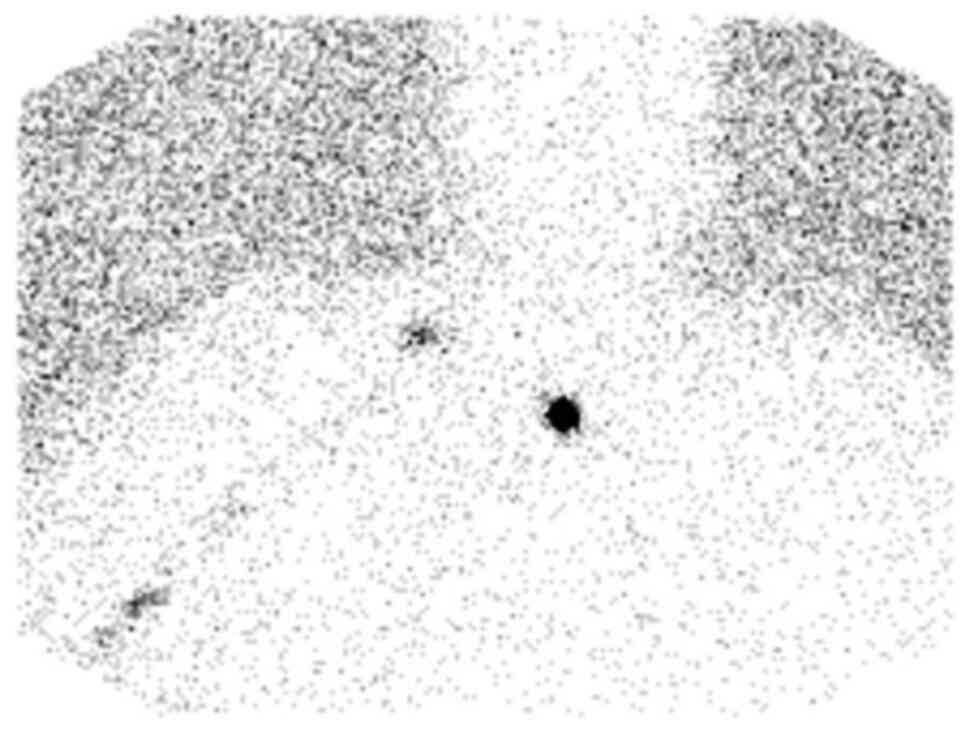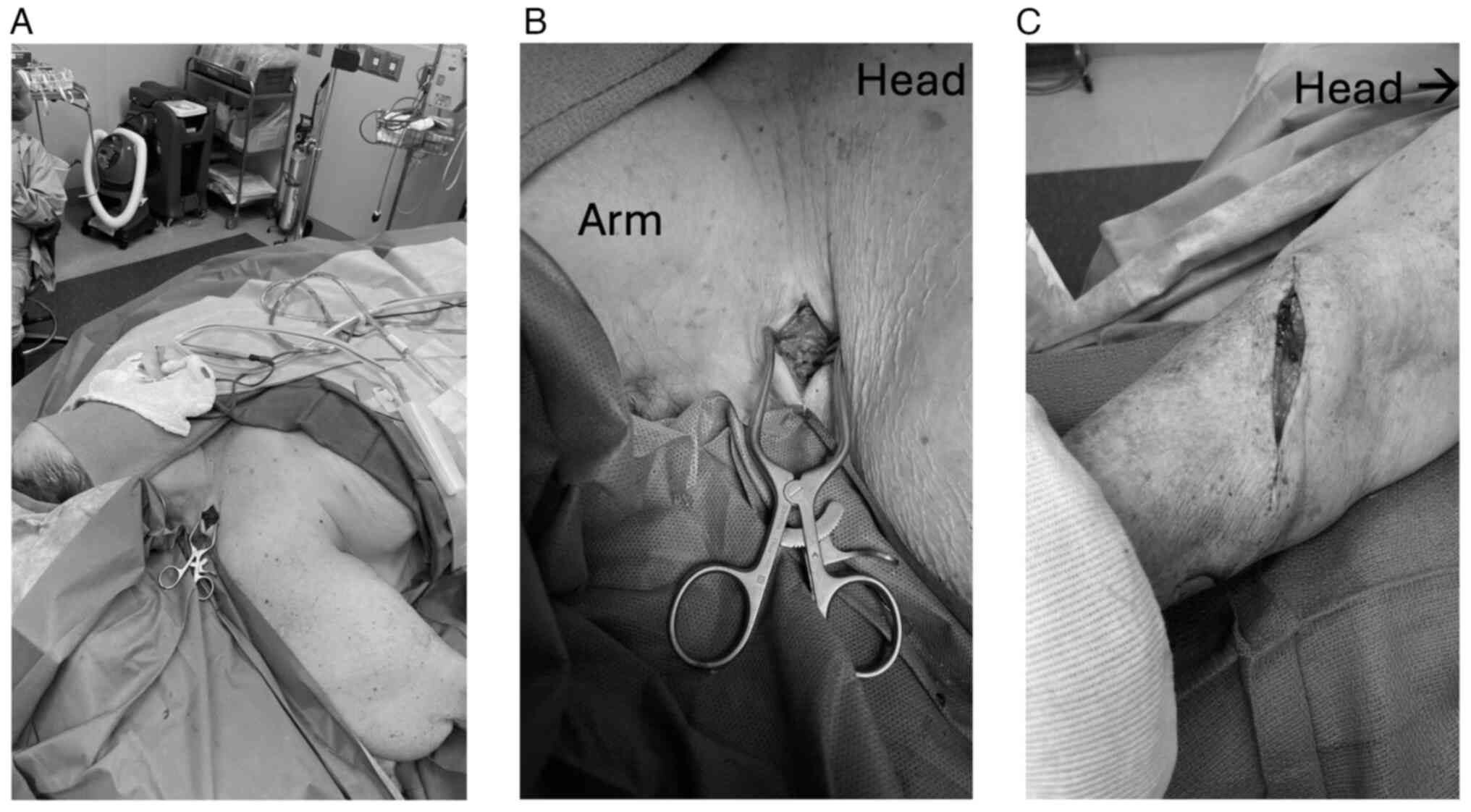Skipped sentinel lymph node basin in a patient with forearm cutaneous melanoma: A case report
- Authors:
- Published online on: March 26, 2024 https://doi.org/10.3892/ol.2024.14366
- Article Number: 233
Abstract
Introduction
Sentinel lymph node (SLN) biopsy constitutes a key diagnostic tool in the treatment and staging of melanoma (1,2). By virtue of being the first lymph node to drain a cutaneous lesion, the SLN is predictive of the metastatic status of a regional lymph node group (3,4). The presence of metastatic disease in a SLN remains an important predictor of survival (4). It has previously been shown that drainage patterns can be altered in patients with melanoma and previous axillary dissection, such as truncal melanoma mapping to cervical lymph nodes (5). Recent studies have demonstrated that there in fact exists a great variation in the lymphatic drainage in patients with malignant melanoma as some patients have demonstrated drainage to lymph nodes outside of conventional nodal basins. This concept referred to as ‘interval nodes’, highlights the link between a primary melanoma and its regional nodal basin (1,6).
We describe an unusual localization of a limb malignant melanoma to a neck basin in a patient with no prior node axillary node dissection.
Case report
The presented patient is followed in our Melanoma clinic at the authors' institution. All surgical procedures were also performed at the authors' institution. The patient was consented separately for her surgical care and for being included in this research manuscript.
The patient is a 71-year-old Caucasian female who presented to our clinic in May of 2023 as a referral from a community dermatologist with malignant melanoma lesions on her forehead measuring 0.4 mm in depth and on her right forearm measuring 1mm in depth (Fig. 1). Her past medical history is significant for benign essential hypertension, hyperlipidemia, obesity, urinary retention, and UTI. Her surgical history is significant for a cesarean section. She has no known allergies. Her family history is significant for heart disease in her father.
The lesions were present since January of 2023 and had increased in size over time. No nodes were palpable in either the neck, parotid or axilla. Both the history, clinical and dermatoscopic characteristics of the lesions provided the basis for the diagnosis of melanoma. Subsequent histological examination (dermatopathology) confirmed the diagnosis of malignant melanoma: forehead lesion Breslow thickness was 0.4 mm, mitotic rate was less than 1 per square mm Clark's, with no ulcerations present; and right forearm lesion Breslow thickness was 1 mm, mitotic rate was 1 per square mm Clark's, with ulceration present.
A preoperative lymphoscintigram was performed with approximately 0.5 mCi of Tc-99m labeled LYMPHOSEEK® (technetium Tc 99m tilmanocept, Cardinal Health, OH, USA) administered as four intradermal injections around the site of the right forearm lesion. Subsequently, multiple spot views of the head, neck, and chest were obtained for lymph node localization. The preoperative lymphoscintigram demonstrated tracking of radiotracer to the right supraclavicular region and no uptake in the right axilla (Fig. 2).
In conformity with the AJCC Classification, given the report that the forehead lesion is 0.4 mm in depth with no ulcerations present, we performed a wide excision only to the level of frontalis muscle fascia (Fig. 3A) followed by primary closure for the forehead melanoma, as there was no indication for SLN biopsy. However, given the report that right forearm melanoma is 1 mm in depth with ulceration present, we performed wide excision as well as SLN of the right supraclavicular region (Fig. 3B and C). We marked out a 1 cm margin around the biopsy site in the forearm and then injected technetium-99m followed by methylene blue for intraoperative lymph node identification. We listened with the Geiger counter, there was no uptake in the axilla, which correlated with the preoperative lymphoscintigram, and there was uptake in the right supraclavicular region along the trapezius in level 5 of the right neck. We then marked out a transverse incision in the right neck, incised through the skin and subcutaneous tissue, identified the trapezius muscle, identified some of the cutaneous nerves and the deeper motor nerves going to the trapezius and retracted those anteriorly and along the border of sternocleidomastoid and deep cervical based nodes identified a cluster of lymph nodes which were carefully dissected out. The count of the lymph node external to the patient was 606 Sievert. The final count in the right neck was 0 Sievert. No additional nodes were taken. Postoperative analysis revealed margins to be negative. Lymph node biopsy results were also negative for melanoma on hematoxylin and eosin (H&E) staining and SOX10 and HMB45 immunostaining. The patient followed up 2 weeks postoperatively. Her incisions were healing appropriately and she is overall doing well. Pathology from her surgical excisions from both the forehead and forearm demonstrated a melanoma of final depth of 0.4 and 3 mm respectively with negative margins. Lymph node biopsy demonstrated lymph node negative for melanoma. The patient will continue to follow up with the medical oncology team for routine melanoma surveillance every 3 to 6 months for 5 years.
Discussion
Prior studies have demonstrated great variation in the lymphatic drainage in patients with malignant melanoma and have highlighted cases of interval nodes and unusual localization to regional nodal basins, most common in the head and neck, followed by the upper extremity (1,2,7). We presented a rare case of localization of a right forearm malignant melanoma to the right supraclavicular node, skipping the axillary basin. Although it is unclear how prior axillary node dissection may impact localization pattern, our case highlights a patient with no prior axillary node dissection, other surgeries or radiation in the area. The presented patient also had the co-existence of a lesion on the forehead measuring 0.4 mm in depth and non-ulcerated.
In our patient, preoperative lymphoscintigram applied to the right forearm lesion demonstrated no uptake in the axilla but an uptake in the right supraclavicular region. This correlated with the intraoperative findings using a handheld Geiger counter, which confirmed a signal only in the right supraclavicular region along the trapezius and level 5. Knowledge of this ‘skipped sentinel lymph node’ pattern outlined in this paper will add to our understanding of disease localization, future metastasis and unique presentations. This can also potentially set the ground for future investigation into the mechanism behind this phenomenon.
Acknowledgements
Not applicable.
Funding
Funding: No funding was received.
Availability of data and materials
The datasets used and analyzed during the current study are available from the corresponding author on reasonable request.
Authors' contributions
OFN and JC contributed to the study design, writing and revisions of this manuscript. OFN and JC confirm the authenticity of all the raw data. Both authors have read and approved the final manuscript.
Ethics approval and consent to participate
Written informed consent was provided by the patient.
Patient consent for publication
The patient provided written informed consent for the publication of their data.
Competing interests
The authors declare that they have no competing interests.
Glossary
Abbreviations
Abbreviations:
|
SLN |
sentinel lymph node |
|
AJCC |
American Joint Committee on Cancer |
|
H&E |
hematoxylin and eosin |
References
|
McMasters KM, Chao C, Wong SL, Wrightson WR, Ross MI, Reintgen DS, Noyes RD, Cerrito PB and Edwards MJ; Sunbelt Melanoma Trial Group, : Interval sentinel lymph nodes in melanoma. Arch Surg. 137:543–549. 2002. View Article : Google Scholar : PubMed/NCBI | |
|
Clary BM, Brady MS, Lewis JJ and Coit DG: Sentinel lymph node biopsy in the management of patients with primary cutaneous melanoma: Review of a large single-institutional experience with an emphasis on recurrence. Ann Surg. 233:250–258. 2001. View Article : Google Scholar : PubMed/NCBI | |
|
Gershenwald JE, Colome MI, Lee JE, Mansfield PF, Tseng C, Lee JJ, Balch CM and Ross MI: Patterns of recurrence following a negative sentinel lymph node biopsy in 243 patients with stage I or II melanoma. J Clin Oncol. 16:2253–2260. 1998. View Article : Google Scholar : PubMed/NCBI | |
|
Gershenwald JE, Thompson W, Mansfield PF, Lee JE, Colome MI, Tseng CH, Lee JJ, Balch CM, Reintgen DS and Ross MI: Multi-institutional melanoma lymphatic mapping experience: The prognostic value of sentinel lymph node status in 612 stage I or II melanoma patients. J Clin Oncol. 17:976–983. 1999. View Article : Google Scholar : PubMed/NCBI | |
|
Johnson C, Intenzo C, Mastrangelo MJ, Feeney K and Berger AC: Altered drainage patterns in patients with melanoma and previous axillary dissection. J Dermatol. 40:564–566. 2013. View Article : Google Scholar : PubMed/NCBI | |
|
Uren RF, Howman-Giles R, Thompson JF, McCarthy WH, Quinn MJ, Roberts JM and Shaw HM: Interval nodes: The forgotten sentinel nodes in patients with melanoma. Arch Surg. 135:1168–1172. 2000. View Article : Google Scholar : PubMed/NCBI | |
|
Matter M, Nicod Lalonde M, Allaoua M, Boubaker A, Liénard D, Gugerli O, Cerottini JP, Bouzourene H, Bischof Delaloye A and Lejeune F: The role of interval nodes in sentinel lymph node mapping and dissection for melanoma patients. J Nucl Med. 48:1607–1613. 2007. View Article : Google Scholar : PubMed/NCBI |












